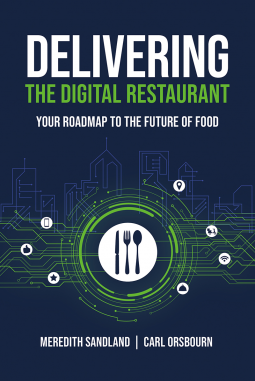
Delivering the Digital Restaurant
Your Roadmap to the Future of Food
by Meredith Sandland and Carl Orsbourn
This title was previously available on NetGalley and is now archived.
Send NetGalley books directly to your Kindle or Kindle app
1
To read on a Kindle or Kindle app, please add kindle@netgalley.com as an approved email address to receive files in your Amazon account. Click here for step-by-step instructions.
2
Also find your Kindle email address within your Amazon account, and enter it here.
Pub Date 12 Oct 2021 | Archive Date 10 Jan 2022
Mascot Books | Amplify Publishing
Talking about this book? Use #DeliveringtheDigitalRestaurant #NetGalley. More hashtag tips!
Description
The omnichannel disruption that upended retail has finally come to the restaurant industry. Restaurateurs must shift how they think, behave, and invest to survive and thrive. Today’s consumers are well-conditioned in their expectations: they want the same tech-savvy, on-demand, and frictionless interactions with restaurants that they get in every other vertical.
If you think your 1,000-unit restaurant chain is too big to fail, remember that 1,000-unit Sears closed nearly all of its stores after it filed for bankruptcy in February 2019.
If you think your local family independent restaurant is too beloved to fail, remember the Amazon effect changed the face of main street and traditional retailing.
Delivering the Digital Restaurant explores the massive disruption facing American restaurants through first-hand accounts of food industry veterans and start-up entrepreneurs innovating the future of food. Combining sociological observations, rich industry data, and insider knowledge, Delivering paints a picture of how food is evolving and how you as a leader, owner, or operator can successfully innovate and meet the new consumer demands to capitalize on the opportunities ahead.
Those who understand this digital disruption will be better positioned to embrace the innovation that consumers are demanding. Those who resist will surely be left behind.
Advance Praise
“It’s time for every restaurant to evolve beyond their four walls. Sandland and Orsbourn explain why consumers are demanding improved off premise convenience and how technology is enabling new ways to interact with food. As an owner, executive, investor, or general manager, this is a must-read.” —Greg Creed, Former CEO, Yum! Brands
“The next frontier for restaurants is to expand hospitality through technology. This book reads as a how-to guide for restaurateurs looking to apply technology to benefit the consumer, not just tech for the sake of tech.” —Danny Myer, CEO, Union Square Hospitality Group; Founder, Shake Shack
“Any aspiring or current leader in the food industry will love Delivering the Digital Restaurant. It will help you build your unique vision for how a restaurant wins in the years ahead.” —Kat Cole, Former President, Focus Brands
“Delivering the Digital Restaurant illuminates the impact of evolving consumer behavior and expectations on the restaurant industry and how entrepreneurs are leveraging technology to reimagine the restaurant of the future.” —Eurie Kim, Managing Director and Investor, Forerunner Ventures
“What an informative and cutting-edge read. The industry has never had a book like this: the business of restaurants. If you’re in the restaurant industry, it could be the most important book you ever buy." —Betsy and Matt Borland, Founders and Owners of East End Tap and Table in Lexington, Kentucky
Available Editions
| EDITION | Hardcover |
| ISBN | 9781645439486 |
| PRICE | US$26.95 (USD) |
Featured Reviews
The convergence of computer technology with drastically changing consumption behavior has huge implications for the food industry. Consumers have gotten nutrition from either grocery stores or food service establishments forever since the rise of business. Amazon started to put this on its head when we stopped going to stores and having the goods come to our places of residence.
Most recently, accelerated by the covid Pandemic, the same thing occurred within the food service industry. Instead of going to grocery stores and restaurants, we can now have the restaurant bring the food to us. In a world where we need nutrition to fuel our lifestyles, this is not only a matter of convenience, it is a matter of freeing up more time to do things we like to do without much interruption.
All this has massive consequences to restaurants and food service organizations. Meredith Sandland and Carl Orsbourn do an excellent job looking at these from all angles, show avenues for restaurant owners to address the challenges that lie ahead and fantasize at times about what the future may behold for all of us.
A must=read for the food industry professional.
 Monnie R, Reviewer
Monnie R, Reviewer
This book is ideal for restaurant owners, so in the interest of full disclosure, I am not one. The topic, though, is of great interest to me as a former newspaper business writer/editor, restaurant reviewer and blogger and, maybe more importantly, half of a couple who visited a restaurant at least four times a week throughout most of our empty nest years.
It wasn't always that way. When I was a teenager, the only dining out I did happened when a friend had a sleepover (back in the '50s, we called them slumber parties) and we all ate what our host's mom cooked. Contrast that to today, when there's a Starbucks on every corner - unless, of course, a Dunkin' Donuts got there first. Want Chinese? Check. Ribs? Check. How about pasta, burgers or chicken wings? Check, check and check. We can eat inside, pick it up at a drive-thru window or have it delivered. Throughout it all, though, restaurant margins have remained razor thin. And then came the unthinkable: Total shutdown for nearly a year in our state and others, thanks to a killer virus that as I write this still threatens lives around the world and prompts us to avoid going inside anything.
Moving forward, what can, should or will happen to the industry remains unclear, but one thing is certain: It ain't gonna return to the good old days. So it is that I wanted to find out what experts have to say. And what they say in this book should be a wake-up call for restaurants that aren't willing to shift gears. A digital divide is already here, and it's growing fast; those who don't get on board most likely will fall between the cracks never to be seen again. Quality food and customer relationships are here to stay, but from now on customers will expect both to happen through digital channels.
Among the eye-opening statistics is this: At the start of 2020, there were 600,000+ restaurants in this country; in the short space of six months, that number was down by 100,000 - and the industry as a whole lost a quarter of a billion dollars during the year. Besides the pandemic (and at least partly because of), what happened? "We are going from an era in which people go to food to an era in which food goes to people," the authors explain in this book. Blame it also on a drop in nuclear family eating - heck, it's hard to even find a nuclear family these days. And no whether you're in a family or not, few among us have much discretionary time - at least none that we want to spend cooking. Couple that with pandemic restrictions and it's no wonder that 70% of restaurant business today happens at the drive-thru window. As the economy zooms in on the IWWIWWIWI concept - "I want What I Want When I Want It" - the authors emphasize that delivery will be the driving factor for success (inside dining, in fact, may well drop to as low as 25% of a restaurant's total business). But, they add, the bulk of success won't come primarily by way of delivery services like DoorDash and GrubHub - which charge restaurants a substantial percentage of each order and slice already thin profit margins to the bone. And that brings us to (ahem!) Delivering the Digital Restaurant.
This is only the tip of the iceberg; the book is filled with timely, well-researched facts and figures as well as examples of how restaurants can make technology work for them, from concepts like "ghost restaurants" to shared restaurants to no restaurant at all. It also speaks to the need to tempt customers with individualized food choices, loyalty programs and enticingly branded, environment-friendly packaging. And it looks at what evolving technology could mean for the future - some of which is already being tested - such as drones that drop appropriate temperature foods on your doorstep, picnic table or, (gasp!) your dining room table. All this will be made possible, the authors say, by digital platforms that eliminate the guesswork and hone the processes down to an error-free fare-thee-well.
My take[out] on this book which, notably, was delivered to me digitally right to my e-reader, is this: For current and wannabe restaurant owners who want their establishments to be around for the next few decades, it's a must-read. For those like me, it's a deliciously enlightening and easy-to-understand look into the here-and-now and tomorrows of the industry. Many thanks to the publisher, via NetGalley, for allowing me to read and review it.
 Jocelyn H, Reviewer
Jocelyn H, Reviewer
<i>Delivering the Digital Restaurant</i> does an admirable job of getting across the necessity of delivery and other off-prem dining options for the future of dining. It's chock-full of interesting statistics, case studies, and new business models that kept me, as someone who doesn't know much about the area, engaged. I very much enjoyed learning about US consumer habits and trends, how cultural differences contribute to different off-prem eating habits in other countries (e.g. the dabbawala system in India), and about the various platform services that are emerging.
This book contains a lot of great information for restauranteurs looking to learn about different delivery models and platforms, or looking to improve on their current implementation. It covers everything from the importance of branding in packaging, to what's important in an online restaurant and menu listing, to the pros and cons of various types of platforms and what options there are for both small restaurants and large chains.
I would have liked to see a bit more substantive reasoning about the future: platforms have been taking losses with VC money buffers, but that can't be sustainable, right? How can restauranteurs trust these business models to be stable? One chapter mentions that only a few platforms are actually profitable and only in high-density areas around the world, so is a long-term delivery solution tenable in most of the US? It'd be great to have some numbers or studies about population density and feasibility of profitable delivery networks.
Similarly with ghost kitchens; there's mention that rent is heavily subsidized by VC funds and that things will change. If rents or fees go up to cover the deficit, will it still be cheaper than opening a new location? And in either case, if the fees for delivery end up on the consumer side, are there any studies that estimate how much of more they're willing to pay? The text assumes that people will be willing to pay for convenience, but how much before a significant amount of the consumer base loses interest?
But these are minor quibbles, and probably questions that would be very difficult to answer given the current state of the world and given how new these developments are. Overall, I learned a lot reading this book, and it was a fascinating peek into the industry.
 Gemma J, Reviewer
Gemma J, Reviewer
As digital technologies change many industries, this book is a useful discussion with examples and strategies. Overall this book would benefit those in the industry, or researchers, writers and forecasters. Thank you to NetGalley for a copy of this book in exchange for an honest review.
Quite a well done writing. The author uses personal stories to demonstrate current culture and changes regarding digitalization and its effect on restaurants.
Well researched describing the evolution of the food industry over the last decades, describing how internet, ability to order food online and deliver, and the effect the pandemic has had.
Great read for restauranteurs, and for those interested in learning the second and third order effects digitization has.







